- Home
- Medical news & Guidelines
- Anesthesiology
- Cardiology and CTVS
- Critical Care
- Dentistry
- Dermatology
- Diabetes and Endocrinology
- ENT
- Gastroenterology
- Medicine
- Nephrology
- Neurology
- Obstretics-Gynaecology
- Oncology
- Ophthalmology
- Orthopaedics
- Pediatrics-Neonatology
- Psychiatry
- Pulmonology
- Radiology
- Surgery
- Urology
- Laboratory Medicine
- Diet
- Nursing
- Paramedical
- Physiotherapy
- Health news
- Fact Check
- Bone Health Fact Check
- Brain Health Fact Check
- Cancer Related Fact Check
- Child Care Fact Check
- Dental and oral health fact check
- Diabetes and metabolic health fact check
- Diet and Nutrition Fact Check
- Eye and ENT Care Fact Check
- Fitness fact check
- Gut health fact check
- Heart health fact check
- Kidney health fact check
- Medical education fact check
- Men's health fact check
- Respiratory fact check
- Skin and hair care fact check
- Vaccine and Immunization fact check
- Women's health fact check
- AYUSH
- State News
- Andaman and Nicobar Islands
- Andhra Pradesh
- Arunachal Pradesh
- Assam
- Bihar
- Chandigarh
- Chattisgarh
- Dadra and Nagar Haveli
- Daman and Diu
- Delhi
- Goa
- Gujarat
- Haryana
- Himachal Pradesh
- Jammu & Kashmir
- Jharkhand
- Karnataka
- Kerala
- Ladakh
- Lakshadweep
- Madhya Pradesh
- Maharashtra
- Manipur
- Meghalaya
- Mizoram
- Nagaland
- Odisha
- Puducherry
- Punjab
- Rajasthan
- Sikkim
- Tamil Nadu
- Telangana
- Tripura
- Uttar Pradesh
- Uttrakhand
- West Bengal
- Medical Education
- Industry
Sugar-sweetened beverage intake increases multiple dyslipidemia features, CVD risk

A new study by Danielle Haslam and team found that higher sugar-sweetened beverage (SSB) intake was connected to developing various dyslipidemia traits that have been linked to increased cardiometabolic risk in the US adults. The findings of this study were published in The Journal of Nutrition.
Prospective cohort studies have discovered a link between the use of sugar-sweetened beverages (sodas and fruit drinks) and dyslipidemia. There is minimal evidence relating SSB intake to developing dyslipidemia characteristics such as remnant-like particle (RLP), lipoprotein particle size, and apolipoprotein concentrations. As a result, this study was carried out to investigate the relationship between SSB intake and apolipoprotein, plasma lipoprotein cholesterol, and lipoprotein particle size levels in US adults.
The Framingham Offspring Study and the Women's Health Study were studied by the researchers. Plasma LDL cholesterol, TG, HDL cholesterol, apoB, apoA1, and non-HDL cholesterol concentrations, as well as total cholesterol:HDL cholesterol ratio and apoB:apoA1 ratio, were measured in both cohorts; apolipoprotein E, apolipoprotein C3, RLP-TG, and RLP cholesterol (RLP-C) concentrations were measured in the FOS only. Nuclear magnetic resonance signals for lipoprotein particle subclass concentrations were used to compute particle sizes. Data from food frequency questionnaires were used to estimate SSB intake. The relationships between SSB intake and all lipoprotein and apoprotein measurements were also examined in linear regression models that controlled for confounding variables such lifestyle, food, and conventional lipoprotein risk factors.
The key findings of this study were:
SSB intake was related to LDL cholesterol, apoB, TG, RLP-TG, RLP-C, and non-HDL cholesterol concentrations, as well as total cholesterol:HDL cholesterol and apoB:apoA1 ratios, but not to HDL cholesterol or apoA1 concentrations.
SSB users had smaller LDL-P and HDL-P sizes, lower concentrations of big LDL-Ps and medium HDL-Ps, and greater concentrations of small LDL-Ps, small HDL-Ps, and large TRL-Ps after controlling for established lipoprotein risk factors.
According to these results, increased SSB intake is connected to greater plasma lipoprotein concentrations that have been linked to negative cardiometabolic outcomes, including classic and newer measures of apolipoprotein, lipoprotein cholesterol, and lipoprotein particle concentrations. These findings imply a possible mechanism by which SSB consumption may raise the risk of cardiometabolic diseases: variations in lipoprotein particle sizes.
Reference:
Haslam, D. E., Chasman, D. I., Peloso, G. M., Herman, M. A., Dupuis, J., Lichtenstein, A. H., Smith, C. E., Ridker, P. M., Jacques, P. F., Mora, S., & McKeown, N. M. (2022). Sugar-Sweetened Beverage Consumption and Plasma Lipoprotein Cholesterol, Apolipoprotein, and Lipoprotein Particle Size Concentrations in US Adults. In The Journal of Nutrition (Vol. 152, Issue 11, pp. 2534–2545). Elsevier BV. https://doi.org/10.1093/jn/nxac166
Neuroscience Masters graduate
Jacinthlyn Sylvia, a Neuroscience Master's graduate from Chennai has worked extensively in deciphering the neurobiology of cognition and motor control in aging. She also has spread-out exposure to Neurosurgery from her Bachelor’s. She is currently involved in active Neuro-Oncology research. She is an upcoming neuroscientist with a fiery passion for writing. Her news cover at Medical Dialogues feature recent discoveries and updates from the healthcare and biomedical research fields. She can be reached at editorial@medicaldialogues.in
Dr Kamal Kant Kohli-MBBS, DTCD- a chest specialist with more than 30 years of practice and a flair for writing clinical articles, Dr Kamal Kant Kohli joined Medical Dialogues as a Chief Editor of Medical News. Besides writing articles, as an editor, he proofreads and verifies all the medical content published on Medical Dialogues including those coming from journals, studies,medical conferences,guidelines etc. Email: drkohli@medicaldialogues.in. Contact no. 011-43720751


